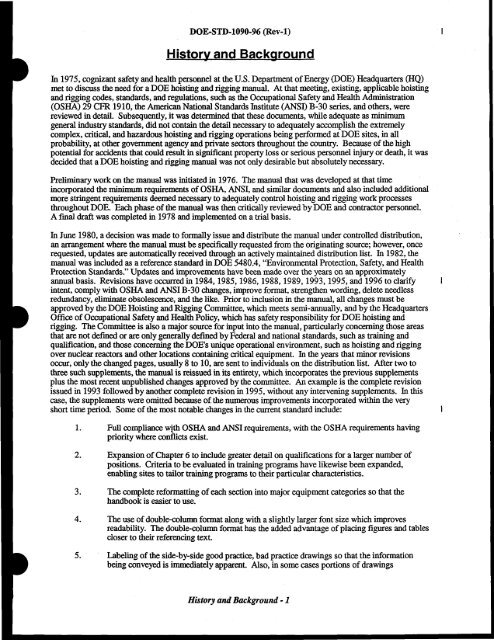DOE-STD-1090-96, DOE Standard Hoisting and Rigging Manual ...
DOE-STD-1090-96, DOE Standard Hoisting and Rigging Manual ...
DOE-STD-1090-96, DOE Standard Hoisting and Rigging Manual ...
Create successful ePaper yourself
Turn your PDF publications into a flip-book with our unique Google optimized e-Paper software.
<strong>DOE</strong>-<strong>STD</strong>-I090-<strong>96</strong> (Rev-I)History <strong>and</strong> BackgroundIn 1975, cognizant safety <strong>and</strong> health personnel at the U.S. Department ofEnergy (<strong>DOE</strong>) Headquarters (HQ)met to discuss the need for a <strong>DOE</strong> hoisting <strong>and</strong> rigging manual. At that meeting, existing, applicable hoisting<strong>and</strong> rigging codes, st<strong>and</strong>ards, <strong>and</strong> regulations, such as the Occupational Safety <strong>and</strong> Health Administration(OSHA) 29 CFR 1910, the American National <strong>St<strong>and</strong>ard</strong>s Institute (ANSI) B-30 series, <strong>and</strong> others, werereviewed in detail. Subsequently, it was determined that these documents, while adequate as minimumgeneral industry st<strong>and</strong>ards, did not contain the detail necessary to adequately accomplish the extremelycomplex, critical, <strong>and</strong> hazardous hoisting <strong>and</strong> rigging operations being performed at <strong>DOE</strong> sites, in allprobability, at other government agency <strong>and</strong> private sectors throughout the country. Because ofthe highpotential for accidents that could result in significant property loss or serious personnel injury or death, it wasdecided that a <strong>DOE</strong> hoisting <strong>and</strong> rigging manual was not only desirable but absolutely necessary.Preliminary work on the manual was initiated in 1976. The manual that was developed at that timeincorporated the minimum requirements ofOSHA, ANSI, <strong>and</strong> similar documents <strong>and</strong> also included additionalmore stringent requirements deemed necessary to adequately control hoisting <strong>and</strong> rigging work processesthroughout <strong>DOE</strong>. Each phase ofthe manual was then critically reviewed by<strong>DOE</strong> <strong>and</strong> contractor personnel.A fmal draft was completed in 1978 <strong>and</strong> implemented on a trial basis.In June 1980, a decision was made to formally issue <strong>and</strong> distribute the manual under controlled distribution,an arrangement where the manual must be specifically requested from the originating source; however, oncerequested, updates are automatically received through an actively maintained distribution list. In 1982, themanual was included as a reference st<strong>and</strong>ard in <strong>DOE</strong> 5480.4, "Environmental Protection, Safety, <strong>and</strong> HealthProtection <strong>St<strong>and</strong>ard</strong>s." Updates <strong>and</strong> improvements have been made over the years on an approximatelyannual basis. Revisions have occurred in 1984, 1985, 1986, 1988, 1989, 1993, 1995, <strong>and</strong> 19<strong>96</strong> to clarifyintent, comply with OSHA <strong>and</strong> ANSI B-30 changes, improve format, strengthen wording, delete needlessredundancy, eliminate obsolescence, <strong>and</strong> the like. Prior to inclusion in the manual, all changes must beapproved by the <strong>DOE</strong> <strong>Hoisting</strong> <strong>and</strong> <strong>Rigging</strong> Committee, which meets semi-annually, <strong>and</strong> by the HeadquartersOffice of Occupational Safety <strong>and</strong> Health Policy, which has safety responsibility for <strong>DOE</strong> hoisting <strong>and</strong>rigging. The Committee is also a major source for input into the manual, particularly concerning those areasthat are not defmed or are only generally defined by Federal <strong>and</strong> national st<strong>and</strong>ards, such as training <strong>and</strong>qualification, <strong>and</strong> those concerning the <strong>DOE</strong>'s unique operational environment, such as hoisting <strong>and</strong> riggingover nuclear reactors <strong>and</strong> other locations containing critical equipment. In the years that minor revisionsoccur, only the changed pages, usually 8 to 10, are sent to individuals on the distribution list. After two tothree such supplements, the manual is reissued in its entirety, which incorporates the previous supplementsplus the most recent unpublished changes approved by the committee. An example is the complete revisionissued in 1993 followed by another complete revision in 1995, without any intervening supplements. In thiscase, the supplements were omitted because ofthe numerous improvements incorporated within the veryshort time period. Some of the most notable changes in the current st<strong>and</strong>ard include:1. Full compliance with OSHA <strong>and</strong> ANSI requirements, with the OSHA requirements havingpriority where conflicts exist.2. Expansion ofChapter 6 to include greater detail on qualifications for a larger number ofpositions. Criteria to be evaluated in training programs have likewise been exp<strong>and</strong>ed,enabling sites to tailor training programs to their particular characteristics.3. The complete reformatting ofeach section into major equipment categories so that theh<strong>and</strong>book is easier to use.4. The use ofdouble-column format along with a slightly larger font size which improvesreadability. The double-column format has the added advantage ofplacing figures <strong>and</strong> tablescloser to their referencing text.5. Labeling ofthe side-by-side good practice, bad practice drawings so that the informationbeing conveyed is immediately apparent. Also, in some cases portions of drawingsHistory <strong>and</strong> Background -1
















